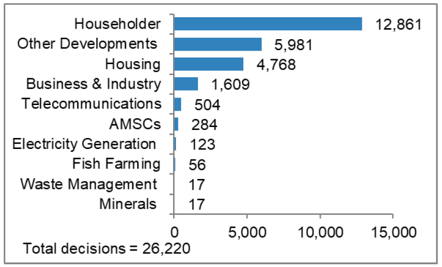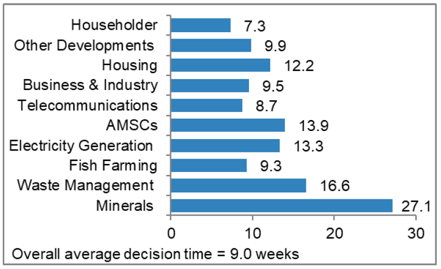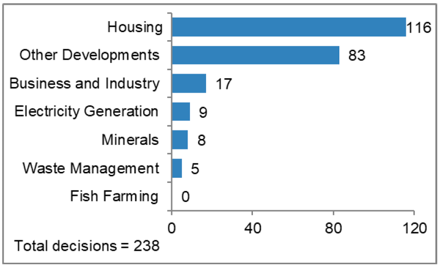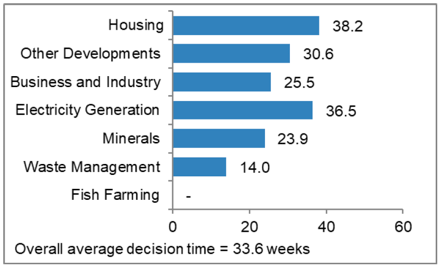Planning performance statistics: fourth quarter 2017-2018 and annual
Latest summary statistics on planning decision-making and timescales for the year April 2017 to March 2018, as well as historic data going back to 2013-2014.
3. Annual average decision times by Development Type
3.1 Local Developments
Local developments include applications for changes to individual houses and smaller developments for new housing as well as applications covering areas of development such as minerals, business & industry, waste management, electricity generation, freshwater fish farming, marine finfish farming, marine shellfish farming, telecommunications, Approval of Matters Specified in Conditions ( AMSCs) and other developments.
This section presents annual information on application numbers and average timescales across all local developments, along with separate figures for individual categories.
Chart 13: Post 3rd August 2009 Applications: Local Developments, 2017/18: Number of decisions

Chart 14: Post 3rd August 2009 Applications: Local Developments, 2017/18: Average decision time (weeks)

The average decision time for the 26,220 (post 3rd August 2009) local applications in 2017/18 was 9.0 weeks, quicker by an average of just over a day per application compared with 2016/17 (9.2 weeks) and the quickest annual average since the start of this data collection in 2012/13.
Chart 14 shows that average decision times vary between types of development. The largest share of local developments is for householder developments (almost 50%) and these have the shortest decision time of on average 7.3 weeks. Minerals applications (0.1% of all local decisions) have the longest average decision time equal to 27.1 weeks.
During the year 2017/18 there was a total of 1,139 local development decisions where the clock had been stopped at some point within the application process (4.3% of all local development decisions). On average almost 19 weeks has been removed for these applications, and this will have had an effect on overall average decision times. For the previous year, there were 944 local development decisions where the clock had been stopped at some point (3.5% of all local application decisions). See Annex 15.1 for further details.
Some local developments are subject to Environmental Impact Assessments ( EIAs). Results for these developments are not included here and instead are reported separately in the detailed tables ( Annual, 2017/18: Tables 23 & 28).
In addition, there were 1,671 local developments decided in 2017/18 that had processing agreements in place, with almost 80% of these meeting agreed timescales. Developments with processing agreements are not included in average time calculations.
The overall decision time for local developments in 2017/18 was the quickest over the last five years (Table 1). In 2017/18 the average decision times for householder (7.3 weeks), other developments (9.9 weeks), housing (12.2 weeks) and electricity generation (13.3 weeks) were all the quickest since the start of this data collection in 2012/13.
Between 2016/17 and 2017/18 electricity generation developments had the biggest improvement in average decision time from 19.2 weeks to 13.3 weeks. For business and industry, telecommunications, fish farming, waste management and minerals developments there were increases in average decision times compared to 2016/17. The increase in the average decision time for waste management can partly be explained by two applications with decision times of almost one year. The increase for mineral decisions was strongly influenced by a single application that took over three years for a decision.
Table 2 shows the figures for all applications including legacy applications up to 2016/17.
Table 1: Post 3rd August 2009 Applications: Local Developments: Annual average decision times by Development Type
| Post - 3rd August Local Developments | 2017/18 | 2016/17 | 2015/16 | 2014/15 | 2013/14 | 2012/13 | ||||||
|---|---|---|---|---|---|---|---|---|---|---|---|---|
| Number of decisions | Average decision time (weeks) | Number of decisions | Average decision time (weeks) | Number of decisions | Average decision time (weeks) | Number of decisions | Average decision time (weeks) | Number of decisions | Average decision time (weeks) | Number of decisions | Average decision time (weeks) | |
| Householder | 12,861 | 7.3 | 13,400 | 7.3 | 13,641 | 7.4 | 14,115 | 7.5 | 13,904 | 7.7 | 13,446 | 8.0 |
| Other Developments | 5,981 | 9.9 | 5,919 | 10.0 | 6,126 | 10.3 | 6,099 | 10.4 | 6,258 | 10.5 | 5,822 | 11.3 |
| Housing | 4,768 | 12.2 | 4,899 | 12.7 | 5,590 | 13.7 | 5,807 | 14.5 | 5,762 | 15.2 | 5,563 | 17.2 |
| Business & Industry | 1,609 | 9.5 | 1,738 | 9.3 | 1,941 | 10.4 | 2,257 | 10.7 | 2,370 | 11.1 | 2,531 | 11.8 |
| Telecommunications | 504 | 8.7 | 457 | 8.1 | 441 | 7.9 | 416 | 7.6 | 404 | 8.5 | 301 | 8.5 |
| AMSCs | 284 | 13.9 | 294 | 14.5 | 319 | 13.0 | 318 | 14.8 | 302 | 17.4 | 255 | 16.3 |
| Electricity Generation | 123 | 13.3 | 178 | 19.2 | 561 | 17.4 | 626 | 22.4 | 861 | 23.1 | 1,247 | 21.2 |
| Fish Farming | 56 | 9.3 | 44 | 8.5 | 84 | 9.4 | 53 | 13.3 | 63 | 12.5 | 43 | 10.6 |
| Minerals | 17 | 27.1 | 28 | 19.9 | 39 | 35.0 | 25 | 17.7 | 47 | 15.8 | 35 | 26.9 |
| Waste Management | 17 | 16.6 | 29 | 11.6 | 22 | 10.8 | 23 | 17.8 | 55 | 19.4 | 89 | 16.3 |
| TOTAL | 26,220 | 9.0 | 26,986 | 9.2 | 28,764 | 9.7 | 29,739 | 10.1 | 30,026 | 10.6 | 29,332 | 11.4 |
Table 2: All Applications: Local Developments: Annual average decision times by Development Type
| All Applications Local Developments | 2017/18 | 2016/17 | 2015/16 | 2014/15 | 2013/14 | 2012/13 | ||||||
|---|---|---|---|---|---|---|---|---|---|---|---|---|
| Number of decisions | Average decision time (weeks) | Number of decisions | Average decision time (weeks) | Number of decisions | Average decision time (weeks) | Number of decisions | Average decision time (weeks) | Number of decisions | Average decision time (weeks) | Number of decisions | Average decision time (weeks) | |
| Householder | 13,400 | 7.3 | 13,644 | 7.5 | 14,116 | 7.5 | 13,904 | 7.7 | 13,450 | 8.1 | ||
| Other Developments | 5,920 | 10.0 | 6,131 | 10.5 | 6,102 | 10.5 | 6,264 | 10.8 | 5,833 | 11.7 | ||
| Housing | 4,901 | 12.8 | 5,616 | 14.4 | 5,836 | 15.3 | 5,831 | 17.5 | 5,671 | 20.9 | ||
| Business & Industry | 1,738 | 9.3 | 1,944 | 11.2 | 2,259 | 10.9 | 2,385 | 12.9 | 2,548 | 13.0 | ||
| Telecommunications | 457 | 8.1 | 441 | 7.9 | 416 | 7.6 | 404 | 8.5 | 301 | 8.5 | ||
| AMSCs | 294 | 14.5 | 319 | 13.0 | 319 | 15.1 | 303 | 18.0 | 255 | 16.3 | ||
| Electricity Generation | 178 | 19.2 | 561 | 17.4 | 626 | 22.4 | 863 | 23.5 | 1,251 | 21.7 | ||
| Fish Farming | 44 | 8.5 | 84 | 9.4 | 53 | 13.3 | 63 | 12.5 | 43 | 10.6 | ||
| Minerals | 28 | 19.9 | 40 | 35.1 | 25 | 17.7 | 49 | 22.3 | 36 | 31.6 | ||
| Waste Management | 30 | 15.5 | 22 | 10.8 | 23 | 17.8 | 57 | 26.8 | 95 | 28.7 | ||
| TOTAL | 26,990 | 9.2 | 28,802 | 10.0 | 29,775 | 10.3 | 30,123 | 11.3 | 29,483 | 12.4 | ||
3.2 Major Developments
Major developments include applications for developments of 50 or more homes, as well as other applications covering areas of development such as minerals, housing, business & industry, waste management, electricity generation, freshwater fish farming, marine finfish farming, marine shellfish farming and other developments. Classification between local and major developments depends on the particular development type. For example, housing developments are classed as major when the application is for 50 or more dwellings or for a site that exceeds two hectares, whereas electricity generation is classed as major when the capacity of the generating station is or exceeds 20 megawatts.
Details for the classification of all development types can be found here: http://www.gov.scot/Resource/Doc/278390/0083657.pdf .
This section presents annual information on application numbers and average timescales across all major developments, along with separate figures for individual categories.
Chart 15: Post 3rd August 2009 Applications: Major Developments, 2017/18: Number of decisions

Chart 16: Post 3rd August 2009 Applications: Major Developments, 2017/18: Average decision time (weeks)

The average decision time for the 238 (post 3rd August 2009) major applications in 2017/18 was 33.6 weeks, quicker by almost three weeks per application compared with 2016/17 (36.4 weeks).
Charts 15 and 16 show that a large share (almost 49%) of major developments are for housing developments that have an average decision time of 38.2 weeks.
During the year 2017/18 69 applications, 29% of all major development decisions had involved a clock stop at some point within the application process. The average time stopped was 46.2 weeks for these applications. This will have had an effect on overall average decision times. See Annex 15.1 for further details.
In addition there were a further 93 major development applications concluded in 2017/18 that were subject to separate processing agreements. Over 73% of these applications met agreed timescales that had been set between developers and local authorities. Applications subject to processing agreements are not included in average time calculations.
Tables 3 and 4 give figures over five years. Due to the small number of applications for some types of major developments, average decision times may be volatile between types and years and can be skewed by a few lengthy decisions. See Annex 15.2 for further details.
In 2017/18 the average decision times for major housing and waste management applications were the quickest annual average since the start of this data collection in 2012/13. The average decision times for minerals and business and industry developments improved in 2017/18 compared to the previous year while electricity generation and other developments showed increases in average decision times since the previous year.
In 2017/18 there were 42 major applications that took longer than a year for a decision. Nine of these took more than two years; seven taking between two and three years, one just over three years and the longest application taking over seven years. The lengthiest decision was for planning permission in principle for development of a Community Growth Area, comprising housing, neighbourhood centre, community facilities, access roads, open space and landscaping. The application was approved.
Table 3: Post 3rd August 2009 Applications: Major Developments: Annual average decision times by Development Type
| Post - 3rd August Major Developments | 2017/18 | 2016/17 | 2015/16 | 2014/15 | 2013/14 | 2012/13 | ||||||
|---|---|---|---|---|---|---|---|---|---|---|---|---|
| Number of decisions | Average decision time (weeks) | Number of decisions | Average decision time (weeks) | Number of decisions | Average decision time (weeks) | Number of decisions | Average decision time (weeks) | Number of decisions | Average decision time (weeks) | Number of decisions | Average decision time (weeks) | |
| Housing | 116 | 38.2 | 108 | 43.4 | 95 | 40.6 | 113 | 41.3 | 117 | 41.9 | 76 | 40.1 |
| Other Developments | 83 | 30.6 | 94 | 30.4 | 108 | 25.1 | 101 | 28.7 | 105 | 25.9 | 66 | 34.3 |
| Business & Industry | 17 | 25.5 | 26 | 33.2 | 23 | 19.9 | 39 | 33.1 | 41 | 26.6 | 45 | 22.8 |
| Electricity Generation | 9 | 36.5 | 10 | 32.6 | 16 | 31.7 | 19 | 53.6 | 27 | 58.4 | 24 | 50.7 |
| Minerals | 8 | 23.9 | 5 | 30.0 | 16 | 33.6 | 16 | 52.1 | 13 | 20.6 | 21 | 46.6 |
| Waste Management | 5 | 14.0 | 3 | 18.6 | 9 | 22.4 | 9 | 18.4 | 7 | 23.7 | 5 | 22.3 |
| Fish Farming | 0 | - | 0 | - | 1 | 18.0 | 1 | 31.6 | 0 | - | 1 | 4.4 |
| TOTAL | 238 | 33.6 | 246 | 36.4 | 268 | 31.0 | 298 | 36.6 | 310 | 34.6 | 238 | 36.3 |
Table 4: All Applications: Major Developments: Annual average decision times by Development Type
| All Applications Major Developments | 2017/18 | 2016/17 | 2015/16 | 2014/15 | 2013/14 | 2012/13 | ||||||
|---|---|---|---|---|---|---|---|---|---|---|---|---|
| Number of decisions | Average decision time (weeks) | Number of decisions | Average decision time (weeks) | Number of decisions | Average decision time (weeks) | Number of decisions | Average decision time (weeks) | Number of decisions | Average decision time (weeks) | Number of decisions | Average decision time (weeks) | |
| Housing | 108 | 43.4 | 105 | 52.1 | 125 | 54.1 | 147 | 69.9 | 104 | 74.8 | ||
| Other Developments | 96 | 30.3 | 111 | 26.3 | 103 | 32.9 | 115 | 38.7 | 73 | 46.2 | ||
| Business & Industry | 26 | 33.2 | 23 | 19.9 | 41 | 41.3 | 45 | 39.8 | 51 | 56.2 | ||
| Electricity Generation | 10 | 32.6 | 17 | 53.7 | 21 | 69.1 | 27 | 58.4 | 28 | 64.4 | ||
| Minerals | 6 | 39.0 | 18 | 41.8 | 17 | 70.0 | 15 | 59.0 | 23 | 47.4 | ||
| Waste Management | 3 | 18.6 | 9 | 22.4 | 10 | 24.8 | 7 | 23.7 | 7 | 87.4 | ||
| Fish Farming | 0 | - | 1 | 18.0 | 1 | 31.6 | 0 | - | 1 | 4.4 | ||
| TOTAL | 249 | 36.4 | 284 | 37.8 | 318 | 46.4 | 356 | 53.8 | 287 | 61.1 | ||
Contact
There is a problem
Thanks for your feedback